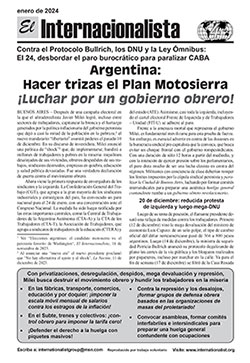
January 2024
Against the Anti-Picketing “Protocol” and Milei’s Anti-Worker Mega-Decree, On January 24, Bypass the Bureaucrats and Shut Down Buenos Aires!
Argentina:
Smash the “Chainsaw” Assault
on Labor and the Unemployed
Fight for a Workers Government!
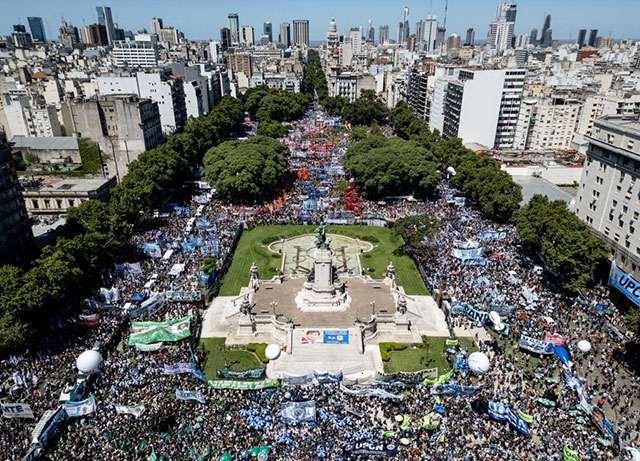
The January 24 national strike, called by the CGT and the other main labor federations in Argentina, against the avalanche of anti-worker decrees and laws by the government of ultra-rightist Javier Milei. The Peronist union tops only sought to pressure legislators to vote “no.” The goal should have been to shut down the capital and Greater Buenos Aires on the road to a real general strike and factory occupations. (Photo: Ezequiel Putruele / Xinhua)
On January 24, Argentina had the first national strike since 2019, as unions, the left and community organizations mobilized against the avalanche of anti-worker legislation by far-right president Javier Milei who took office in early December. While police estimated some 80,000 demonstrators in Buenos Aires, it was certainly much more – up to 200,000 by some counts – heading to a rally outside the National Congress. (It was difficult to get an overview, as many marchers were bottled up in nearby streets, unable to reach the rally site.) In addition, tens of thousands more – perhaps another 150,000 in total – marched in every major city around the country. It could have been far greater except for the decision of the public transit unions to keep trains, subway and buses running until 7 p.m. – limiting the impact on non-unionized workers – and the limited participation of the industrial unions, which mostly stayed in their own areas.
The Peronist1 union leaders who spoke from the stage mainly sought to pressure Peronist legislators to vote against the government’s “Omnibus Law” which would eliminate a panoply of social programs and labor laws, gutting the right to strike and leading to the destruction of whole sectors of the economy. The law did not come to a vote on the 24th, due to disputes among the bourgeoisie, so various left groups are calling for a repeat strike when Congress reconvenes on January 30. But parliamentary tinkering will not stop the onslaught. While a court decision on the 24th stayed the application of some of the anti-labor “reforms,” the vast scope of the government’s plans to destroy any and all protections against the ravages of the capitalist market make clear that the only answer is to mobilize the power of the working class and the oppressed to drive out Milei and establish a revolutionary workers government.
We print below a translation of the El Internacionalista leaflet that was distributed in Buenos Aires on January 24, as well as at solidarity demos in Mexico City, New York and Berlin.
With
privatizations, deregulation, layoffs, huge devaluation
and repression, Milei
is out to destroy the labor movement and plunge working
people into destitution.
- In the factories, transport, commerce, education and everywhere: impose a monthly sliding scale of wages against the ravages of inflation!
- On the subway, trains and buses: for workers control to impose free transit!
- Defend the right to strike with massive picket lines!
- Against repression and evictions, form workers defense groups based on the mass organizations of the proletariat!
- Call assemblies, form inter-factory and inter-union coordinating committees to prepare a powerful general strike with plant occupations
BUENOS AIRES – After an election campaign2 in which the ultra-rightist Javier Milei succeeded, even among sectors of the working class, in capitalizing on the anger and frustration generated by the inflationary policies of the Peronist government which left almost half of the population in poverty, the new “libertarian” president took office on December 10. In his inauguration speech, Milei announced a “shock” program3 which, if implemented, will plunge millions of workers and poor people into destitution: tenants evicted from their homes, workers fired from their jobs, unions destroyed, companies bankrupted, education and public health devastated. It was a real declaration of war against the labor movement.
Now comes the first major response from the unions and the left. The General Confederation of Labor (CGT), which includes the large majority of the industrial and strategic unions of the country, has called a national strike for January 24, with a rally in front of the National Congress. That step was then ratified by the other important union federations, including the Central de Trabajadores de la Argentina Autónoma (CTA-A) and the Workers’ CTA (CTA-T) which include the education (CTERA) and public employee unions (ATE). Likewise, almost all the left, including the United Left and Workers Front (FIT-U) electoral cartel, supports the strike.
In the face of the mortal threat represented by the Milei government, it is essential to mobilize for this test of strength, while warning against illusions in the pro-capitalist union bureaucrats that called the strike, who seek to avoid a head-on clash with the union-busting government. Lasting only 12 hours starting at noon, and intended to put pressure on the members of Congress, the strike is far from a class-struggle fight against the regime. Class-conscious militants should break the limits imposed by the Peronist union leadership and shut down the city of Buenos Aires, while seeking to form inter-union committees to prepare for a real general strike leading to a revolutionary workers government.
December 20: a Reduced Leftist Protest, and an Ultra-Rightist Mega-Decree
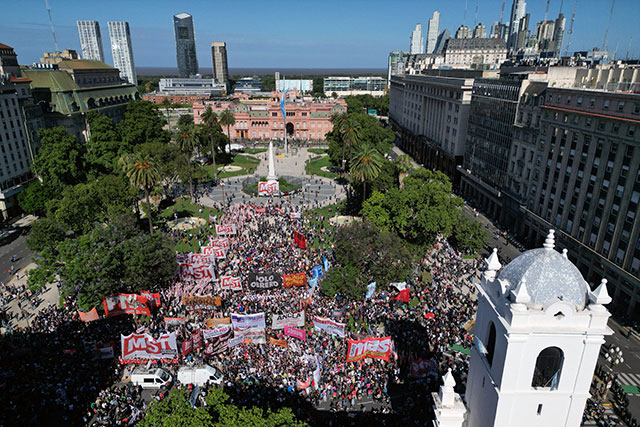
Plaza de Mayo half-full during the protest called by the left against Milei’s anti-worker policies, 20 December 2023. (Photo: Luis Robayo / AFP)
After his inauguration, the new president fired off a burst of anti-worker measures. First (December 12) came a mega-devaluation by the minister of economy Luis Caputo: in a single blow, the official exchange rate of the U.S. dollar went from 366 to 800 Argentine pesos. Then (December 14), security minister Patricia Bullrich announced her police “protocol” outlawing street blockades and roadblocks by piqueteros,4 even for marching in the street. By the weekend (December 17) it was leaked from the Casa Rosada (Argentina’s White House) that a mega “decree of necessity and urgency” (DNU) would soon be issued containing an avalanche of deregulations, privatizations, “freeing” of prices and “reforms” (especially regarding labor) which would target the working people as a whole and large sectors of the petty bourgeoisie.
It was a frontal challenge to the unions and the left. The piquetero organizations together with the parties of the FIT-U had already announced a protest for the 20th. “50,000 people will be mobilized” proclaimed Eduardo Belliboni, the main media figure of the leftist piquetero groups and leader of the Polo Obrero (Workers Pole), the piquetero organization of the Partido Obrero (PO – Workers Party). Newly elected federal deputy of the Partido de Trabajadores Socialistas (PTS – Socialist Workers Party) Christian Castillo tweeted that there would be “tens of thousands” in the streets. The Milei government circulated a classic lie of the Latin American right wing: the spectre of “Cuban and Venezuelan agents.” There was speculation in the press over whether the demonstrators would dare to break Bullrich’s anti-picketing protocol.
From early in the morning it was announced on loudspeakers and posters in the city’s train stations that “el que corta no cobra” (anyone who blocks will not get paid). This was the threat made by Milei in his inaugural speech, that anyone stopping traffic on the streets would have their social plan cancelled. This could be catastrophic for the unemployed who depend on the benefits they receive through the piquetero organizations. A hotline for snitches was also set up to denounce anyone who “forces” them to attend the protest, and the security minister even threatened to charge the organizations for the cost of the police operation. Both Bullrich and Milei went to the central department of the Federal Police to observe the development of the leftist demonstration from the “situation room.”
As it turned out, only about 10,000 demonstrators attended: more than the 3,000 announced by the Ministry of Security, but far from the 50,000 or the tens of thousands expected by the organizers. Bullrich mocked the “mini-march” and boasted: “Today the Avenue 9 de Julio was not cut. Today the Pueyrredón Bridge was not cut..... They did not come in buses because they knew that all of them were going to be stopped.” The bourgeois press summed up: “With a big police operation, the picketers’ march was meager and did not block the streets” (Clarín). So the threat of repression was enough to impose the anti-piquetero “protocol.” Seeing the reduced attendance, President Milei left the federal police headquarters and went to the Casa Rosada, where a few hours later he announced his mega DNU which consists of 83 pages and repeals or modifies some 300 laws on social matters.
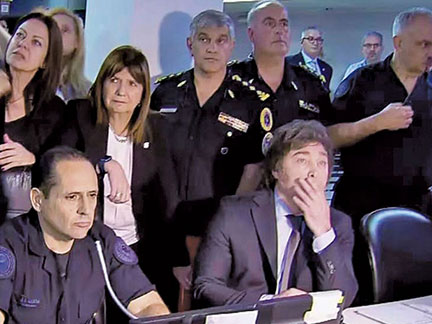 Head of state Javier Milei
and security minister Patricia Bullrich observe the
development of the left-wing protest on the screens of the
Federal Police situation room, 20 December 2023.
Head of state Javier Milei
and security minister Patricia Bullrich observe the
development of the left-wing protest on the screens of the
Federal Police situation room, 20 December 2023. The anti-popular measures of the mega-decree “Bases for the Reconstruction of the Argentine Economy” constitute an unprecedented attack on Argentine workers. They represent a dramatic economic transformation of Argentina toward total opening of the market and complete subordination to the interests of international capital. They attack head-on the right of the working class to organize and defend itself, assailing – or eliminating outright – gains that were the fruit of decades of hard class struggle. Among the decrees are:
- Repeal of the Rent Law, which will allow prices to go through the roof
- Laying the groundwork for the transformation of all state enterprises into corporations with a view to their privatization.
- Repeal of the Supply Law and other programs, eliminating price controls on food and basic necessities.
- Gradually eliminate energy, gas and transportation subsidies.
- Undermine strikes in “essential” or “transcendental” industries by forcing workers to maintain minimum service levels of 75 percent (for health care, education, transportation, utilities, telecommunications and air traffic) or 50 percent in almost all strategic food production, transportation and export industries.
- Picket lines preventing scabs from working and other militant union actions would be considered just cause for dismissal.
- Severance payments will be drastically reduced.
- The “probationary period” of employment during which employers are free to dismiss at will is raised from three to nine months.
- All limits on exports are eliminated.
Unlike what happened in the afternoon with the scant participation in the left-led protest, this juggernaut of anti-popular measures provoked a wave of semi-spontaneous “cacerolazos” (pots-and-pans protests) with hundreds and thousands expressing their horror at Milei’s decrees. Every neighborhood in the capital had at least one, and many converged towards the Congress, taking the main street. They also took place in many districts of Buenos Aires province and in other parts of the country. The anti-picketing “protocol” was quickly trashed in the face of these protests and the police did not dare to disperse them violently, except for launching one attack in the city of Cordoba. Of course, banging pots and pans in protest will not stop a hard-line government like Milei’s, but it indicates the discontent that is there to be mobilized.
We say the cacerolazos were semi-spontaneous, because in addition to isolated individuals, there was participation of petty-bourgeois sectors of the Kirchnerist wing of Peronism,5 whose piquetero organizations boycotted the march of the left in the afternoon. What is not true is the claim by the PTS that the “demonstration called by the left filled Plaza de Mayo and broke the new repressive protocol,”6 nor that thereby “We opened the way so that that same night thousands would also make the pots and pans ring out.”7 The truth is that on the 20th the members of the FIT-U and its piquetero organizations and related union currents occupied only half the Plaza and the street in front and they yielded to the “protocol,” avoiding challenging it frontally and ostentatiously.
The publicized march route was to begin with a rally in front of the Congress and another one at the Obelisk on Avenue 9 de Julio, the largest thoroughfare in the capital. From there, the two columns would cross 9 de Julio and head towards the rally at Plaza de Mayo (the square opposite the Casa Rosada, a traditional focal point of protests). However, on the day of the protest, perhaps based on estimates of a much lower than expected attendance, the location of the “march” was changed to barely two blocks from the Plaza de Mayo, avoiding all the main avenues and streets. Moreover, shortly before the FIT-U communiqué announcing the change, a quick walk around the Congress area revealed that there was not a single major police detachment stationed there. The police had been informed well in advance.
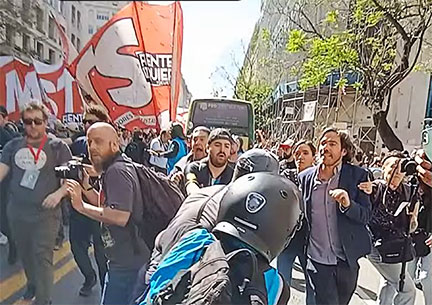 Buenos Aires city police
(center, wearing helmet) assault PST federal deputy Nicolas
del Caño (right), 20 December 2023. Workers should demand:
Cops out – Form workers defense groups to defend pickets and
demonstrations! (Video
screenshot from Izquierda Diario)
Buenos Aires city police
(center, wearing helmet) assault PST federal deputy Nicolas
del Caño (right), 20 December 2023. Workers should demand:
Cops out – Form workers defense groups to defend pickets and
demonstrations! (Video
screenshot from Izquierda Diario)As they arrived at Plaza de Mayo in the “march” on Diagonal Norte, demonstrators were in one lane of the street, marching slowly with rows of police on either side, and then, when enough people gathered, they took both lanes (for all of one block), which was then proclaimed a great victory. It was there that the police beat some demonstrators and went after PTS deputy Nicolás del Caño, then withdrawing and allowing the taking of both lanes. Although the repressive operation only consisted of 5,000 police (2,000 of them city cops, who Bullrich accused of lacking “firmness”), the impact of the threats and the relatively limited number of demonstrators may have made it difficult to “cut through” a police cordon at sensitive points. But to present the protest as a success that “opened the way” to subsequent protests when no attempt was made to break the police siege only serves to disorient militants.
December 20 was the 22nd anniversary of the Plaza de Mayo massacre amid the heroic street battles of 2001 in which 39 people were killed by the police, triggering a general strike and the resignation of President Fernando de la Rúa who fled in a helicopter. What was at stake in this 20 December 2023 was, as expressed by the head of the government of the capital city, Jorge Macri, “the logic of who controls the street.” His assertion that “Order is here to stay,” is far from conclusive, but Milei and Bullrich had the upper hand in this first skirmish. If the left had openly challenged the anti-picketing measures, if it had offered resistance and forced the repressive apparatus to show its hand, the cacerolazos would indeed have played out in support of the left, which would have been at the forefront of the resistance. Instead, it finds itself once again tailing along after the Peronists.
Dec. 27: A Legalistic Protest, Followed by the Omnibus Law
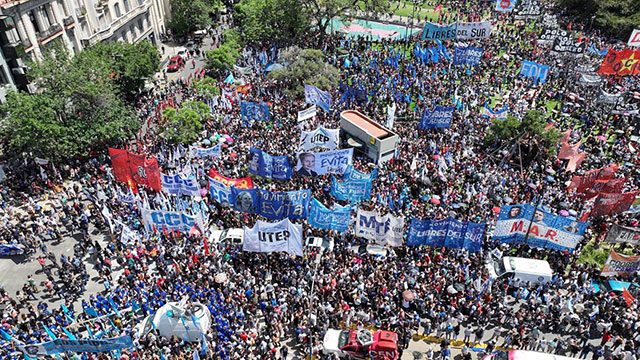
Protest against Milei's mega-decree outside Argentina's Supreme Court on December 27 brought together the left and the Peronist trade-union movement. This time there were tens of thousands of demonstrators in the streets, shattering the “anti-picketing protocol” of Security Minister Bullrich. (Photo: Leandro Blanco / Telam)
The anti-picketing protocol is an effort to readjust the historical balance of class forces in Argentina, completely erasing the influence of the piquetero organizations. Milei’s ambition is to root out Peronism, gut the unions and eliminate the electoral left outright, branding everyone, wrongly in each case, as “communists.” His presidency will not be just another episode of a reactionary government, to be followed by a supposedly “progressive” one. Make no mistake: Milei is playing for keeps, and he has the backing of large sectors of the national bourgeoisie, as well as of the imperialist agencies. The working class needs an even more determined revolutionary Marxist vanguard, to mobilize the superior force of the Argentine and international working class in an all-out class struggle.
The self-proclaimed libertarian “anarcho-capitalist” Milei is seeking to get rid of Peronism and any hint of “collectivism.” It is difficult to find a historical precedent for such a radical transformation of what has been one of the most protectionist and state-interventionist economies in Latin America. The very title of the decree is in part a tribute to the Bases and Starting Points for the Political Organization of the Argentine Republic by Juan Alberdi, considered the intellectual author of the Constitution of 1853. In that treatise, Alberdi laid out his vision of a republic that embraced the free market and approvingly quoted Simón Bolívar’s statement that “the new states of formerly Spanish America need kings with the name of president.” Undoubtedly, this is an ideological inspiration for the current Argentine president.
His predecessor, Alberto Fernández of the Peronist coalition Frente de Todos (now converted into the Union for the Fatherland, or UxP), had the distinction of being the first democratically elected president of Argentina not to face a single national strike, despite the abysmal collapse of workers’ living standards under his government. This was due to his close collaboration with the union chiefs. Milei has shown no interest in negotiating with the CGT, and his decree pursues two of the most important economic sources of the Peronist union bureaucracy. The first is the dues checkoff, quite common among pro-capitalist labor unions around the world. The second is a vast financial empire built around health care plans managed by the semi-corporatist unions.8
This system of subcontracting social works was granted by the military dictatorship of Juan Carlos Onganía at the end of the 1960s, essentially as a way of buying off the union leaders of the Peronist opposition. It turned union bureaucrats into de facto executive directors of health insurance companies, through which they maintain a black box of dubious financial transactions. The CGT leaders can sleep peacefully in the face of the impoverishment of the working class, but they will defend their businesses with the ferocity of any mafioso. Milei has challenged the CGT and threatened its economic base. But in spite of the willingness of the union leaders to reach an agreement with the new president, he has not been willing, up to now, to offer concessions.
This was seen last December 27 when the CGT organized a huge protest in front of the Supreme Court, to bolster its lawsuit seeking an injunction against Milei’s mega-decree for alleged “unconstitutionality.” This time tens of thousands of trade unionists, piqueteros and leftists came out, overflowing into the streets in open violation of the Bullrich protocol. The implementation of some aspects of the labor reform was postponed during the long summer vacation of the courts until mid-February. But seeing that this “legalitarian strike” kept the mobilization within legal channels, seeking to put pressure on the courts, Milei responded that same night with the publication of his Omnibus Law, another package of “reforms” which this time seeks to alter or eliminate some 600 laws.
Some provisions of the December 20 mega DNU take effect immediately, unless Congress votes against it, while others require legislative action to implement them. The centerpiece of the Omnibus Law is to approve in advance the mega DNU and then grant two years of emergency legislative power to the executive, with the option to extend it for another two years upon the decision ... of the president. This project for a president-monarch and the abdication by Congress of its constitutional powers was too much even for right-wing sectors, which would thus lose all influence in the country’s political affairs. As a result, Milei, whose supporters hold only 40 of the 257 seats in the Chamber of Deputies, had to negotiate with the “dialoguist opposition.”
The provisional result, on the eve of the January 24 national strike, is that the Congressional “vacation” would be for one year, and its extension would depend on the decision of Congress. Several measures of the mega-decree would still require legislative discussion and approval. Even so, adoption of the Omnibus Law, which could take place at any time, would deal a tremendous blow to workers’ rights and interests. Thus:
- It would hand over the retirement (social security) fund to the national treasury while establishing that any increase in pensions would be fixed by executive decree.
- It would raise penalties for obstructing the normal functioning of transportation or public services by providing for prison sentences for protesting.
- It would expand the right of “legitimate self-defense” of the police and explicitly authorize shooting a fleeing “suspect” in the back.
- It would grant the executive the power to negotiate concessions of natural resources (such as lithium and oil) to private companies without the approval of state and local governments.
- The conversion of state enterprises into corporations would proceed apace, including the privatization of Aerolíneas Argentinas.
- And, of course, the labor “reform” to weaken unions as much as possible is moving ahead.
The logic of the slimmed-down Omnibus Law is that the legislators would give Milei a year to do the dirty work before they return to the usual parliamentary horse-trading. If he encounters resistance in the legislative chambers, it can’t be ruled out that the “libertarian” who aspires to accumulate and use all the resources of the state against the workers movement may resort to a plebiscite, a typical pseudo-democratic maneuver of bonapartist rulers. However, a plebiscite has no legally binding character, and given the scope of Milei’s program of unrestricted executive power, it could require a “self-coup” to carry it out, like the 1992 coup d’état in Peru by President Alberto Fujimori, another political “outsider” whose hard-right program clashed with his weakness in Congress. But for that, Argentina’s repressive apparatus comes up short.
January 24 Strike: Form Inter-Factory Coordinating Committees
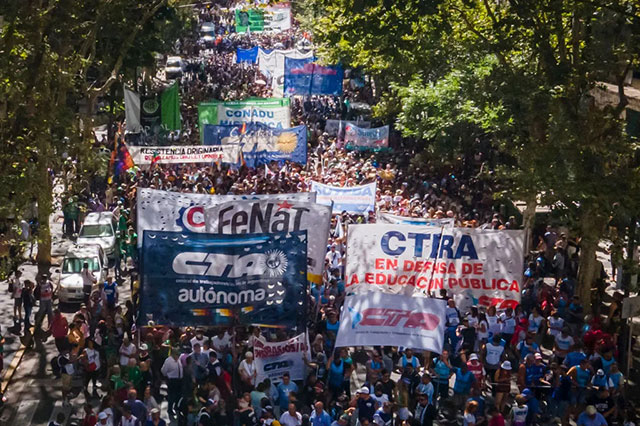
Many contingents were bottled up in nearby streets, unable to reach the concentration point at the Plaza de los Dos Congresos. Above: the two CTAs on Avenida de Mayo. (Photo: Marcelo Endelli / Getty Images)
Although the CGT leadership held out hope of negotiation with the government and judicial intervention, the publication of the Omnibus Law convinced it that a show of force would be necessary. So on December 28 the CGT leadership announced an active national strike with a rally in front of Congress for January 24. It will be the earliest-ever general strike against a new government, but it is part of an overall policy of pressure. It will coincide with the convening of the emergency sessions of Congress, and while the co-secretary general of the CGT Héctor Daer commented that, “if they vote in favor [of the Omnibus Law] the deputies will not be able to walk on the street,” the CGT leadership is letting it be known that “what they expect is that the measure of force will enable a dialogue with the Casa Rosada” (Clarín, January 22).
The left has largely limited itself to calling on the Peronist trade-union bureaucracy to undertake action. Most of the FIT-U parties took part in the protest on December 27 under slogans calling on the CGT leadership to call for a national strike with a “plan of struggle.” So the CGT proceeded to call for an active national strike, with a concentration at the Congress. What now? The first reaction of the PTS was to call for building the strike with assemblies in the workplaces to discuss how to make the day’s protest as big as possible. The second reaction was to take credit for the push for the strike, as expressed in the January 6 declaration of the presiding committee of the Plenary of Combative Trade Unionism:
“The leaders of the CGT had to call the general strike for January 24 with a rally at the Congress, pressured by the anger and following the December 20 marches to Plaza de Mayo, which we of the combative trade unionism movement, the movement of piqueteros, of social organizations, human rights, women, environmentalists and the left, called.”
What shameless and disorienting self-promotion! Although the CGT leadership was undoubtedly influenced by the fighting spirit that was evidenced in the rather weak protest by the left on December 20, the much bigger semi-spontaneous cacerolazos that same night with the participation of Peronist sectors, and the rally at the Courts on December 27 called by the same Confederation, this self-congratulation overlooks the fact that the union leadership, wedded to the bourgeois Peronist movement, has its own motives for calling for a strike, and that it is the policy of these “labor lieutenants of the capitalist class” which has the upper hand, at least so far. This left confuses, in Bismarck’s famous phrase, who is the horse and who is the rider in this “alliance” in which the Peronists hold the reins.
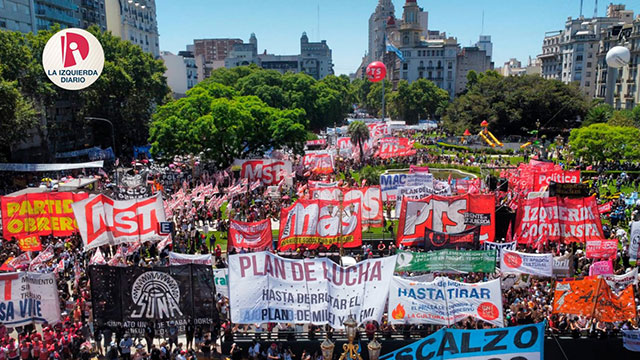
Contingents of the “independent” column of the left in the second tier in front of Congress during the national strike of January 24. Calling on the CGT to undertake a concrete action, like a national strike, is one thing. To beg this hardened bureaucracy, tied to the bourgeois Peronist movement, to formulate a “plan of struggle” is to give it political support, especially knowing that it will refuse at all costs to confront the capitalist system. (Photo: Izquierda Diario)
To reverse the situation, it will be necessary for the revolutionary Marxists – i.e., the Trotskyist-Leninists – to politically combat the pro-capitalist bureaucracy on the basis of a transitional program leading in the direction of the struggle for socialist revolution. This is precisely what the various pseudo-Trotskyist groups do not do. For example, in the declaration of the Plenary Meeting of Combative Unionism, quoted above, the main slogan is: “Let’s rally at Congress and throughout the country, independent of the bureaucracy, to demand a Plan of Struggle to defeat Milei’s chainsaw plan.” In other words, “independently” tail after the bureaucracy. The same idea is repeated by all the components of the Left and Workers Front – Unity:
- Partido Obrero: “We are calling for a plan of struggle following the national strike until this austerity plan is overturned” (January 19).
- Izquierda Socialista: “Combative and left-wing union coordinating committee will strike and march on January 24 for a plan of struggle” (January 17).
Calling on the CGT for a plan of struggle is absurd: it already has one, consisting of pressuring the Peronist opposition.
In the Joint Plenary Meeting held on January 17 by the teachers union ADEMYS and the Plenary of Combative Unionism, representatives of the MST repeated that the national strike was “wrested” from the union bureaucracy. Almost nobody disagreed with this statement. Only Marcelo Ramal, of Política Obrera, warned of the clear intention of the CGT to use the national strike as a mere tool of parliamentary pressure politics and to contain the working class within these channels. He also raised the slogan of promoting inter-factory coordinating committees on the road to the general strike. His intervention was the only one that did not receive applause in the plenary, which shows the depth of the illusions of the others in the policy of pressuring the Peronists. But even raising the slogan of a general strike is insufficient: it is necessary to prepare the struggle for socialist revolution.
It is striking that almost nobody on the left presents a program of transitional demands in their propaganda around the strike of the 24th (and in the prior protests). At most they demand trigger clauses in labor contracts to compensate for wage losses due to galloping inflation. They approach the struggle against Milei’s “Chainsaw Plan” as if it were one more wage negotiation. But with Milei there will be no bargaining. There is no mention of the formation of workers defense groups, which will be indispensable in the face of repression of “unauthorized” strikes and of jailing piqueteros. Nor is there a word about imposing workers control, particularly in the transportation sector, where struggles around fare hikes are foreseeable, or in companies, such as YPF or Aerolíneas, scheduled for privatization.
When they speak of factory occupations, they are referring to bankrupt companies. That would only be a measure to demand government subsidies, whereas to defeat the government’s union-busting plans it would be necessary to mobilize the strength of the workers movement to occupy profitable enterprises. And suppose the CGT were to launch a general strike against the Milei government, as it did partially in the 1980s with a series of powerful general strikes against the government of Raúl Alfonsín, of the Radical Civic Union (UCR, the traditional party of the right-wing capitalist elite). The result was the victory of the Peronist Menem, who came in with the support of the unions on a platform that promised non-payment of the debt, only to turn around to launch the 1990s orgy of privatization, deregulation and financial speculation for which Argentina is still paying today.
The terminal decline of Argentina is inseparable from the decline of the capitalist class that governs it and the rotting of the imperialist system on a world scale. This implies fighting against the imperialist yoke exemplified by the endless austerity plans of the International Monetary Fund, and Milei’s plan of full dollarization, which will lead to the ruin of large sectors of the Argentine economy. But what is the alternative? The Peronist economic regime of protectionism and subsidies is exhausted. As we wrote about last November’s elections, even if Massa had won, he too would have imposed brutal austerity. The only real alternative to Argentina’s economic collapse is to fight for a workers government and international socialist revolution.
Today, in the face of Milei’s enthusiasm for Israel in the midst of its genocidal war, together with the U.S., against the Palestinian Arab population of Gaza, some on the left criticize his government as Zionist. Yet they ignore his alliance with Ukrainian President Volodymyr Zelensky, a puppet of U.S. imperialism and NATO, who was guest of honor at Milei’s inauguration. They refuse to defend Russia against the imperialist proxy war over Ukraine that points to a Third World War whose ultimate aim is to foment counterrevolution and overthrow the Chinese deformed workers state. In fact, far from defending China and Russia against the united onslaught of all the imperialist powers, most of the Trotskyoid left in Argentina, and particularly the heirs of the pseudo-Trotskyist Nahuel Moreno, find themselves in the same trench as US imperialism . . . and Javier Milei.
The League for the Fourth International stresses that to lead a class struggle against the starvation policies and union-busting plans of the present bonapartist-tinged capitalist government, just as against its Peronist predecessors, the main task is to forge an authentic Trotskyist party that fights against capitalism across the board, as part of a reforged Fourth International on the basis of the proletarian internationalist program of Lenin’s Bolsheviks. ■
- 1. Since the time of the governments of General Juan Domingo Perón (from 1946 until his overthrow in 1955, and again from October 1973 until his death on 1 July 1974) the Argentine political scene has been dominated by la grieta (“the rift”) between the bourgeois populist movement of Peronism, with strong roots among the workers, and the anti-Peronism of the traditional right-wing bourgeois elite.
- 2. In the campaign, the “libertarian” Milei” often posed brandishing a chainsaw, vowing to gut workers’ right to strike, privatize all state-owned enterprises, eliminate social programs for the unemployed and do away with the “privileges” of unionized workers. See “Argentina Elections: Mr. Chainsaw vs. Washington’s Favorite Peronist,” The Internationalist (16 November 2023).
- 3. In announcing a “new era” the newly minted president proclaimed that “There is no alternative to adjustment and shock,” La Nación, 11 December 2023.
- 4. Beginning in the late 1990s as many factories in Argentine closed due to the policies of the Peronist government of Carlos Menem – who pegged the Argentine peso to the U.S. dollar, making many Argentine industries uncompetitive internationally – movements of unemployed workers arose that blocked highways with pickets (piquetes). This intensified with the economic crisis of 2001-02, and since then piquetero movements of thousands of jobless workers have persisted, some controlled by the Peronist bureaucracy and others led by leftists, all competing for government financing.
- 5. The bourgeois nationalist movement of Peronism is composed of numerous clans, including the entrenched “historic leaders” of the main trade unions and the more white-collar associations linked to the late president Nestor Kirchner and his wife, also former president and more recently vice president Cristina Fernández de Kirchner (CFK), as well as a reputed “progressive” wing (Patria Grande).|
- 6. Izquierda Diario, 21 December 2023.
- 7. Izquierda Diario special supplement, January 2024
- 8. Unlike the corporatist “unionism” system in Mexico, where the state party took over the trade unions, purging their combative leaderships and integrating them into the state apparatus, the Peronist trade unions in Argentina were born as subsidiaries of the Secretariat of Labor and Social Security under Eva Perón. But after the overthrow of General Perón in 1955, the Peronist unions were orphaned until Juan Carlos Onganía granted them the “outsourced” administration of social works, thus giving them a semi-corporatist character. We Trotskyists fight for the full independence of the unions from the capitalist state, including replacing the collection of union dues by the state and the bosses, with self-financing of the unions by their membership directly.

